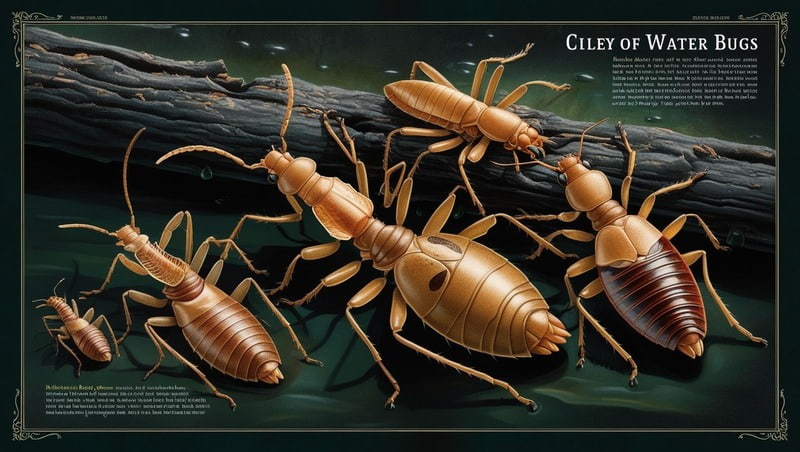Introduction
Water bugs can be a frustrating and unsettling problem for homeowners. These creepy crawlies thrive in damp, dark environments and can quickly become a nuisance if not addressed.
Whether you’ve spotted one scurrying across your kitchen floor or found a few lurking near your bathroom drain, knowing how to get rid of water bugs is essential for maintaining a clean and comfortable home. In this comprehensive guide, we’ll explore what water bugs are, why they invade your space, and practical, effective methods to eliminate them for good.
With clear steps, preventive tips, and expert advice, this article will empower you to tackle water bugs confidently. Let’s dive in and learn how to get rid of water bugs once and for all.
What Are Water Bugs?

Before diving into how to get rid of water bugs, it’s important to understand what they are. Water bugs, often confused with cockroaches, are large insects that belong to the order Hemiptera. They are typically found in moist environments and are drawn to water sources, earning them their name. Common species include the American cockroach (often mistaken for a water bug), giant water bugs, and oriental cockroaches.
These pests are usually brown or black, with flat, oval-shaped bodies and long antennae. They range from 1 to 2 inches in length, making them hard to miss. Unlike other household pests, water bugs prefer damp areas like basements, bathrooms, kitchens, and areas near leaky pipes or drains.
Why Do Water Bugs Invade Homes?
Water bugs enter homes in search of food, water, and shelter. Understanding their motivations can help you prevent infestations and effectively get rid of water bugs. Here are the main reasons they show up:
- Moisture: Water bugs thrive in humid, wet environments. Leaky pipes, clogged drains, or standing water are magnets for these pests.
- Food Sources: Crumbs, grease, and organic debris in kitchens or bathrooms provide a buffet for water bugs.
- Warmth: Especially during colder months, water bugs seek warm, cozy spots indoors.
- Entry Points: Cracks, gaps, and open doors or windows allow water bugs to sneak inside.
By addressing these factors, you can make your home less inviting to water bugs and take the first step toward getting rid of them.
How to Identify a Water Bug Infestation
Spotting a water bug doesn’t always mean you have an infestation, but it’s a warning sign. To confirm whether you need to take action to get rid of water bugs, look for these indicators:
- Sightings: Seeing water bugs during the day is a red flag, as they are nocturnal and usually hide in the dark.
- Droppings: Small, dark, cylindrical droppings near drains, sinks, or baseboards suggest water bug activity.
- Odor: A musty, unpleasant smell in damp areas can indicate a large population of water bugs, especially oriental cockroaches.
- Egg Casings: Water bugs leave behind small, brown egg cases (oothecae) in hidden areas like under sinks or behind appliances.
If you notice these signs, it’s time to act quickly to get rid of water bugs before the problem escalates.
Step-by-Step Guide to Get Rid of Water Bugs
Eliminating water bugs requires a combination of immediate action and long-term prevention. Below is a detailed, step-by-step plan to get rid of water bugs effectively.
1. Eliminate Moisture Sources
Since water bugs are attracted to damp environments, drying out their favorite spots is critical. Here’s how to get rid of water bugs by controlling moisture:
- Fix Leaks: Inspect pipes, faucets, and appliances for leaks. Even small drips can sustain water bugs. According to the Environmental Protection Agency, fixing household leaks can save up to 10% on water bills while deterring pests.
- Use a Dehumidifier: Place a dehumidifier in basements, crawl spaces, or bathrooms to reduce humidity levels below 50%, which is less appealing to water bugs.
- Clear Drains: Clean clogged drains with a mixture of vinegar and baking soda to remove organic buildup that attracts water bugs.
- Improve Ventilation: Install exhaust fans in bathrooms and kitchens to reduce moisture accumulation.
By keeping your home dry, you’ll make it harder for water bugs to survive and reproduce.
2. Clean Thoroughly and Remove Food Sources
Water bugs feed on crumbs, grease, and organic matter. A spotless home is less inviting to them. Follow these cleaning tips to get rid of water bugs:
- Sweep and Vacuum Regularly: Clean floors, especially in kitchens and bathrooms, to remove food particles and debris.
- Wipe Down Surfaces: Use a disinfectant to clean countertops, sinks, and stovetops, eliminating grease and spills.
- Store Food Properly: Keep food in airtight containers and avoid leaving pet food or dirty dishes out overnight.
- Take Out the Trash: Empty garbage cans frequently and use bins with tight-fitting lids to prevent water bugs from accessing food waste.
A 2019 study by the National Pest Management Association found that 54% of pest infestations are linked to poor sanitation. Keeping your home clean is a powerful way to get rid of water bugs.
3. Seal Entry Points
Prevent water bugs from entering your home by sealing gaps and cracks. Here’s how:
- Caulk Cracks: Use silicone caulk to seal gaps around windows, doors, and baseboards.
- Install Door Sweeps: Add door sweeps to exterior doors to block entry points.
- Repair Screens: Fix torn window screens and ensure vents are covered with fine mesh.
- Check Pipes and Drains: Use drain covers or screens to prevent water bugs from crawling up through plumbing.
By blocking their access, you’ll significantly reduce the chances of water bugs invading your home.
4. Use Natural Remedies to Repel Water Bugs
If you prefer eco-friendly solutions, natural remedies can help you get rid of water bugs without harsh chemicals. Try these methods:
- Diatomaceous Earth: Sprinkle food-grade diatomaceous earth in areas where water bugs are active. This powder damages their exoskeleton, causing them to dehydrate and die. Reapply after cleaning or rain.
- Boric Acid: Lightly dust boric acid in cracks, crevices, and under appliances. It’s toxic to water bugs but safe for humans and pets when used sparingly.
- Essential Oils: Mix 10–15 drops of peppermint, tea tree, or eucalyptus oil with water in a spray bottle. Spray in areas where water bugs hide to repel them naturally.
- Vinegar Traps: Place a shallow dish of apple cider vinegar mixed with a drop of dish soap near infested areas. Water bugs are attracted to the scent but drown in the liquid.
These remedies are affordable and effective for small infestations, making them a great starting point to get rid of water bugs.
5. Set Traps for Immediate Control
Traps can help reduce water bug populations quickly. Here are some options to get rid of water bugs:
- Sticky Traps: Place adhesive traps near drains, under sinks, or along baseboards to capture water bugs. Check and replace them regularly.
- Jar Traps: Create a DIY trap by coating the inside of a glass jar with petroleum jelly and placing bait like bread or fruit inside. Water bugs enter but can’t escape.
- Commercial Bait Stations: Use cockroach bait stations containing insecticides like fipronil or hydramethylnon. Place them in high-traffic areas for water bugs.
Traps are most effective when combined with other methods, as they target existing water bugs but don’t address the root cause.
6. Apply Insecticides for Severe Infestations
For large or persistent infestations, chemical insecticides may be necessary to get rid of water bugs. Use these products cautiously:
- Residual Sprays: Apply EPA-approved insect sprays labeled for cockroaches or water bugs in cracks, crevices, and other hiding spots. Avoid spraying near food or pets.
- Insect Growth Regulators (IGRs): IGRs disrupt water bug reproduction, preventing nymphs from reaching adulthood. They’re a long-term solution for infestations.
- Professional-Grade Products: Brands like Advion or Demon WP are highly effective but should be used according to label instructions.
Always follow safety guidelines and consider consulting a professional if you’re unsure about handling insecticides.
7. Call a Professional Pest Control Service
If your efforts to get rid of water bugs aren’t working, it’s time to call in the experts. Professional pest control services offer:
- Thorough Inspections: Exterminators identify water bug hiding spots and entry points you might miss.
- Targeted Treatments: Professionals use advanced tools and chemicals to eliminate water bugs safely and effectively.
- Ongoing Monitoring: Many services offer follow-up visits to ensure the infestation is fully eradicated.
According to a 2021 survey by Pest Control Technology, 68% of homeowners who hired professionals for pest issues reported complete resolution within a month. If water bugs persist, don’t hesitate to seek expert help.
Preventing Future Water Bug Infestations
Once you’ve successfully gotten rid of water bugs, prevention is key to keeping them away. Follow these tips to maintain a bug-free home:
- Maintain Cleanliness: Continue regular cleaning to eliminate food and water sources.
- Monitor Moisture: Check for leaks and use dehumidifiers in damp areas.
- Inspect Regularly: Look for signs of water bugs in hidden areas like under sinks or behind appliances.
- Seal Gaps: Periodically check and reseal entry points to keep water bugs out.
- Use Repellents: Apply natural repellents like essential oils or diatomaceous earth as a preventive measure.
By staying proactive, you can prevent water bugs from returning and enjoy a pest-free home.
Common Mistakes to Avoid When Trying to Get Rid of Water Bugs
When tackling a water bug problem, avoid these pitfalls:
- Ignoring Small Signs: A single water bug can indicate a larger issue. Act quickly to prevent an infestation.
- Using Too Much Insecticide: Overapplying chemicals can be hazardous and less effective. Follow product instructions carefully.
- Neglecting Prevention: Focusing only on elimination without addressing moisture or entry points allows water bugs to return.
- Skipping Professional Help: If the infestation is severe, delaying professional intervention can worsen the problem.
Being mindful of these mistakes will improve your success in getting rid of water bugs.
Fun Fact: Water Bugs vs. Cockroaches
Did you know that many people mistake water bugs for cockroaches? While they share similarities, true water bugs (like giant water bugs) are aquatic insects that live near ponds and streams, rarely invading homes. The pests we call “water bugs” in households are often oriental or American cockroaches. Knowing the difference helps you choose the right methods to get rid of water bugs effectively.
Conclusion
Dealing with water bugs can feel overwhelming, but with the right approach, you can eliminate them and prevent future infestations. By addressing moisture, cleaning thoroughly, sealing entry points, and using traps or repellents, you’ll be well on your way to a pest-free home. For stubborn infestations, don’t hesitate to call a professional to get rid of water bugs quickly and safely.
Start with small, consistent steps like fixing leaks and setting traps, and you’ll soon notice a difference. With persistence and the strategies outlined in this guide, you can confidently take control and get rid of water bugs for good. Your home deserves to be a comfortable, bug-free sanctuary—let’s make it happen!






More Stories
How To Style A Coffee Table For Every Home
How to Decorate Your Home for Christmas Like a Pro
15 Easy Steps to Build a DIY Pergola: A Complete Homeowner’s Guide